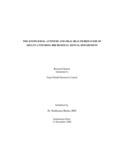Please use this identifier to cite or link to this item:
https://hdl.handle.net/20.500.14356/216| Title: | A Study on Health Needs Assessment and School Health Program in Nepal |
| Authors: | Baidya, P |
| Issue Date: | 2001 |
| Keywords: | health needs health promotion school children school health |
| Abstract: | Background Since a significant number of students are enrolled in school level education in Nepal and the school is one of the agencies that contribute to the health of the students as well as the community people there is still paucity of information on existing situation of school health in Nepal. In this context, the study aims at assessing the health needs of the school children and the current practices on school health. Methods The study covered 480 students from grade IV and V from three districts viz Gorkha, Chitwan and Kathmandu. Clinical examination of the students, observation of the school students, questionnaire and focused group discussions were the main methods used for the collection of data. Results Among the students pallor (30%), cyanosis (0.83%), dirty nails (29%), poor personal hygiene (21.4%) and skin diseases (28%) were found. Missing and cavity tooth (25.8%) and unhealthy gums (68.9%), night blindness (7.5%), nearsightedness (8.2%) and far sightedness (0.4%), impaired hearing (7.1%), enlarged liver (2.7%) and spleen (2%) were also prevalent among the students. About 14.8% students had suffered from gastro-intestinal problems. Two-third of the schools surveyed had no games and sport facilities for children. About one-fifth of the playground was not safe and about half of the schools surveyed were in noisy settings. Four-fifth of the schools had inadequate and inappropriate furniture. First aid kits were found only in 16.6% schools. One of the schools had provision for student's health check up. More than 80% of the students had knowledge of three or more causes of diseases. About 16.6% students were victims of injuries/accidents but only 28.7% among them had received first aid treatment following injuries/accidents. Conclusions Schools should be developed as entry point for health promotion with active participation of teachers, parents and students. |
| URI: | http://103.69.126.140:8080/handle/20.500.14356/216 |
| Appears in Collections: | Research Abstract |
Files in This Item:
| File | Description | Size | Format | |
|---|---|---|---|---|
| 398[1].pdf | 951.14 kB | Adobe PDF |  View/Open |
Items in DSpace are protected by copyright, with all rights reserved, unless otherwise indicated.
